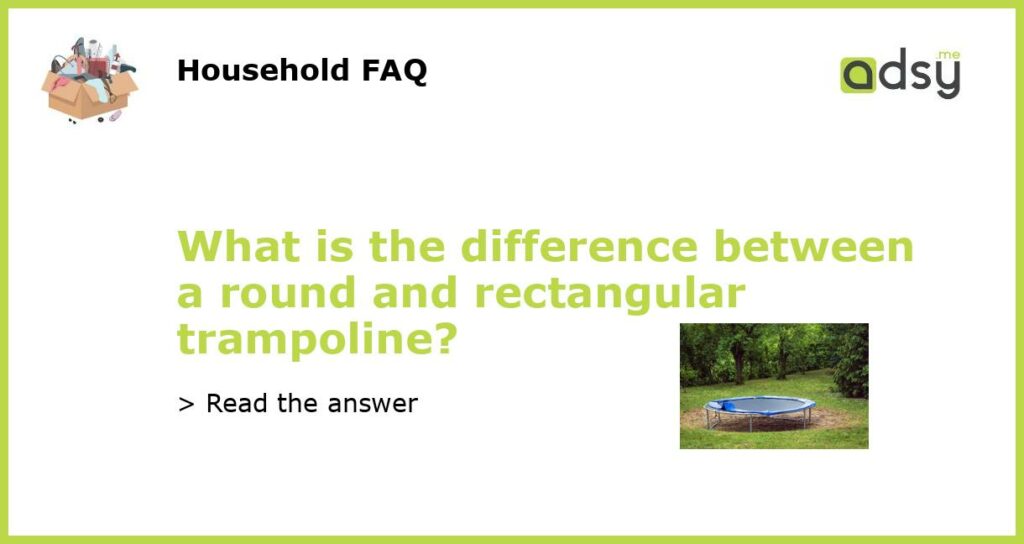Round vs Rectangular Trampoline: Which One Should You Choose?
Trampolines are a great source of fun and exercise for people of all ages. They provide an exhilarating bounce that can entertain kids for hours and offer a low-impact workout for adults. When it comes to choosing a trampoline, one of the first decisions you’ll need to make is whether to go for a round or rectangular shape. Both options have their pros and cons, and understanding the differences between the two can help you make an informed decision. So, let’s dive into the details and compare round and rectangular trampolines.
Shape and Design
Round trampolines are the most common type found in backyards. As the name suggests, they have a circular shape which provides an evenly distributed bounce across the surface. The springs on round trampolines are positioned in a symmetrical pattern, allowing jumpers to easily bounce back to the center. The circular design is simple and versatile, making it ideal for recreational jumping and basic tricks.
On the other hand, rectangular trampolines have a more elongated shape, resembling a traditional gymnastics trampoline. The springs are positioned in a diagonal pattern, giving jumpers a more powerful and controlled bounce. Rectangular trampolines are preferred by gymnasts, athletes, and experienced jumpers who want to perform complex tricks and flips. The rectangular shape also provides a larger jumping area compared to round trampolines of the same size.
Bounce Quality and Performance
The shape and design of a trampoline greatly impact its bounce quality and performance. Round trampolines offer a softer and more forgiving bounce. The springs work together to distribute the jumper’s weight evenly, resulting in a gentle upward force. This makes round trampolines suitable for younger children and beginners who are still learning how to control their jumps.
Rectangular trampolines, on the other hand, provide a more powerful and responsive bounce. The springs are positioned diagonally, which allows for greater rebound and height. This makes rectangular trampolines the preferred choice for athletes and advanced jumpers who want to perform high jumps and intricate tricks. The rectangular shape also enables a more consistent bounce across the entire jumping surface, making it easier to control and perform precise movements.
Safety Features and Enclosure Options
When it comes to safety features, both round and rectangular trampolines have their own advantages. Round trampolines are commonly equipped with safety nets that surround the entire jumping area. The circular shape and symmetrical spring pattern make it easier to attach a net enclosure. The net helps prevent jumpers from falling off the trampoline, minimizing the risk of injuries.
Rectangular trampolines, on the other hand, may require additional accessories to ensure safety. The elongated shape can make it more challenging to find a properly fitted safety net. However, many manufacturers offer custom enclosure options designed specifically for rectangular trampolines. Some rectangular trampolines also come with built-in safety features such as reinforced frames and padding around the edges.
Space Requirements and Installation
Another factor to consider is the space available in your backyard and the installation process. Round trampolines typically take up less space and are easier to install. Their compact design allows for more flexibility in placement and requires fewer securing points. Round trampolines are also easier to assemble and disassemble, making them more portable if you need to move or store them.
Rectangular trampolines, on the other hand, require a larger space due to their elongated shape. They also require more securing points to maintain stability. The installation process may be more involved, requiring precise measurements and extra care to ensure proper alignment. Rectangular trampolines are more suitable for larger yards where there is ample space for a dedicated trampoline area.
Cost and Availability
The cost of a trampoline can vary depending on its size, brand, and additional features. In general, round trampolines are more affordable and widely available. Their popularity has led to a wide range of options and competitive pricing. Round trampolines are commonly sold in sporting goods stores and online retailers.
Rectangular trampolines, on the other hand, tend to be more expensive due to their specialized design and target audience. They are often preferred by professionals and serious jumpers who are willing to invest in a higher-quality and performance-oriented trampoline. Rectangular trampolines may require more research and may be harder to find in local stores, but they can be purchased from specialized trampoline retailers or online.
In conclusion, round and rectangular trampolines have distinct differences in shape, bounce quality, safety features, space requirements, and cost. Round trampolines are versatile, suitable for recreational jumping, and are often a more budget-friendly option. Rectangular trampolines offer a more powerful bounce, larger jumping area, and are favored by athletes and advanced jumpers. Consider your specific needs, available space, and budget before making a decision. Whichever option you choose, remember to follow safety guidelines and supervise jumpers for a safe and enjoyable trampoline experience.






